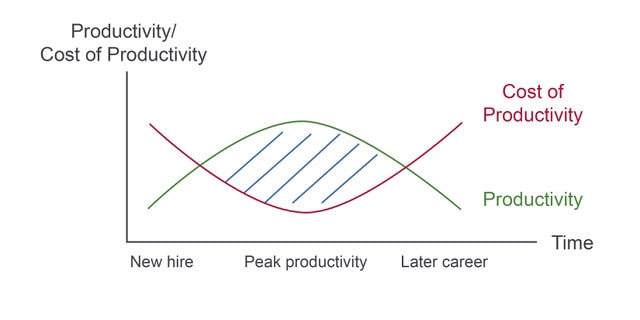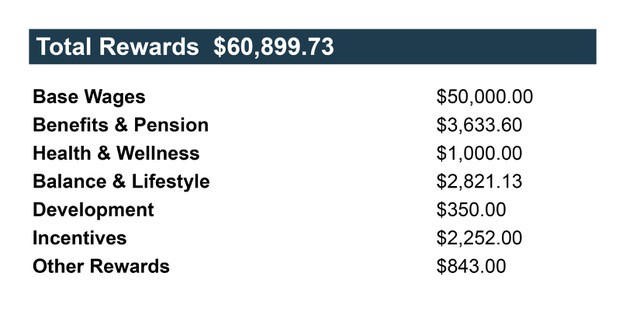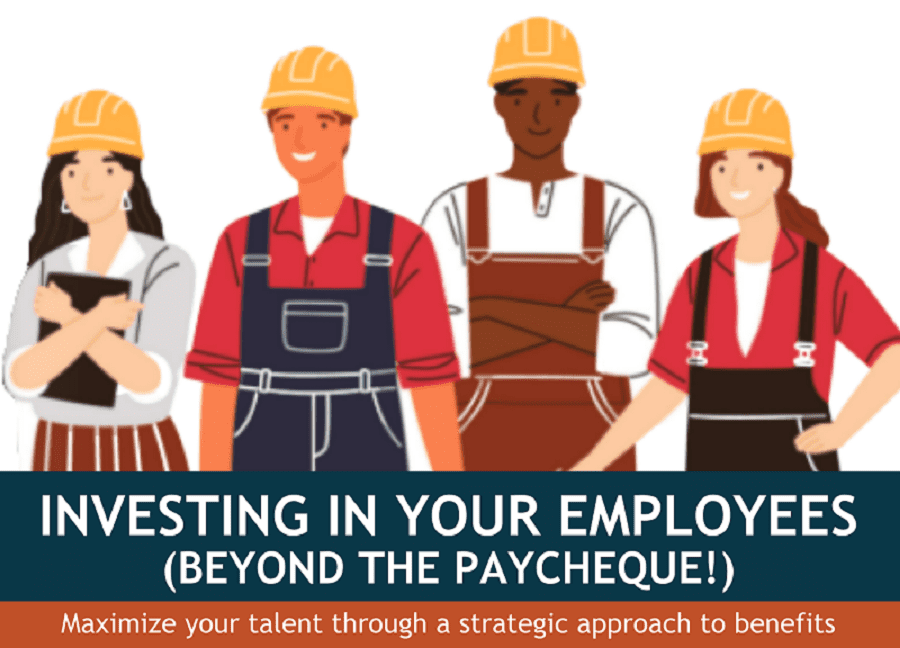Saskatchewan employers are finding it challenging to attract and retain good employees. Not only is there a small pool of qualified people in the trades, but high performers are already being well taken care of because smart employers know the cost to acquire good employees is much higher than the cost of retaining them.
The graph below shows the low productivity of a new hire, which rises as they become more experienced and falls later in their career. The cost curve is the inverse: it’s high relative to productivity at the beginning, falls, and then rises again later in the worker’s career. The key is to attract employees who are aligned with your values and culture, train them quickly so they reach peak productivity, and then retain them, advancing their career when you can, until it is time to help facilitate their retirement when their productivity is declining.

Figure: Mark O’Farrell. Module 1, “Company benefits and pensions,” in Canadian Institute of Certified Executor Advisors course. CICEA, 2020. Used with permission.
Retention experts predicted that we would begin seeing a workplace “turnover tsunami,” as early as 2021. It’s partly due to the pandemic allowing people a year-plus to reflect on what they do, if it’s truly fulfilling, and how they perceive they are valued. How do you take advantage of this ripe opportunity and position your business as an employer of choice?
To be competitive, it is important to invest not only in wages, but in perks and rewards, both tangible and intangible. Gone are the days when a good paycheque, an occasional thank you, and an annual raise were enough. Today people want to work for employers that respect their personal life and care about them as people. And the benefits they seek are those that contribute to their ability to live a better life, find meaning in their work, and advance in their careers.
Let’s face it, the cost of living has increased, and employees’ income doesn’t go as far as it once did. And we know how financial stress can affect employee health and productivity. But employee perception and expectations of compensation are changing. You have an opportunity to guide the conversation, influence perception, and manage expectations.
Imagine being able to communicate the value of your total compensation in dollars per hour. Help your employees — and prospective employees — understand that there is a value to the things you provide beyond the paycheque. If you translate the tangible and intangible into a dollars-per-hour figure, employees can better understand and appreciate the value of their total compensation. That’s just as important when you’re speaking to potential new employees. Chances are that a prospective employee’s current employer hasn’t communicated the value of their benefits this way.

Here’s an example: Instead of a potential employee leaving their interview with your company knowing only that the compensation is $24/hour plus benefits and pension, you could share that the total value of the package is over $29/hour — that’s 21% and $5 per hour higher — and includes benefits and rewards that will recognize them for their work; support their health, wellness, and financial needs during varying stages of life; and promote career advancement. That higher value demonstrates how much you invest in your employees and in their safety, health, wellbeing, and financial future. Be sure to separate the value of incentives such as production bonuses and profit sharing, and include other rewards like team-building social events, years of service awards, and anything unique you do to add value to the employee experience. Remember, on-the-job training has a value and should not be overlooked in your total rewards statement.
Long-term employees know the daily ins and outs of your business better than anybody and they possess remarkable knowledge. A Canadian Apprenticeship Forum Study1 showed that employers estimate a “homegrown” journeyperson (i.e., trained by the company), is 29% more productive than a journeyperson trained elsewhere. Investing in your workers will make them less likely to move on and it will give you a competitive edge.
Communicating how you invest in your employees is critical to retaining them. But you have to walk the talk! Nobody will stay if they feel like they’re stagnating working in the same job or capacity. They need to know their development and contributions matter. Train them and reward them. They will remain engaged, they’ll be more proficient, and your company’s overall performance, innovation, and production will increase, and that’s always good for the bottom line.
Take advantage of the tax credits and programs that make hiring an apprentice more affordable, such as the federal Apprenticeship Job Creation Tax Credit or the Canada-Saskatchewan Job Grant. Attract more young workers and help them apply for the Saskatchewan Youth Apprenticeship (SYA) Industry Scholarship program. Encourage mentorship and promote the transfer of knowledge from your tenured team members to less-seasoned employees. Provide opportunities for webinars, lunch & learns, and the time and flexibility to engage in industry events. And then have employees share what they learn with each other.
Your best assets might already be in your company. Don’t lose them to a better opportunity.
First published in the Winter 2021 edition of We Build Magazine.
- Canadian Apprenticeship Forum. “It Pays to Hire an Apprentice: Calculating the Return on Training Investment for Skilled Trades Employers in Canada.” CFA, 2009.


